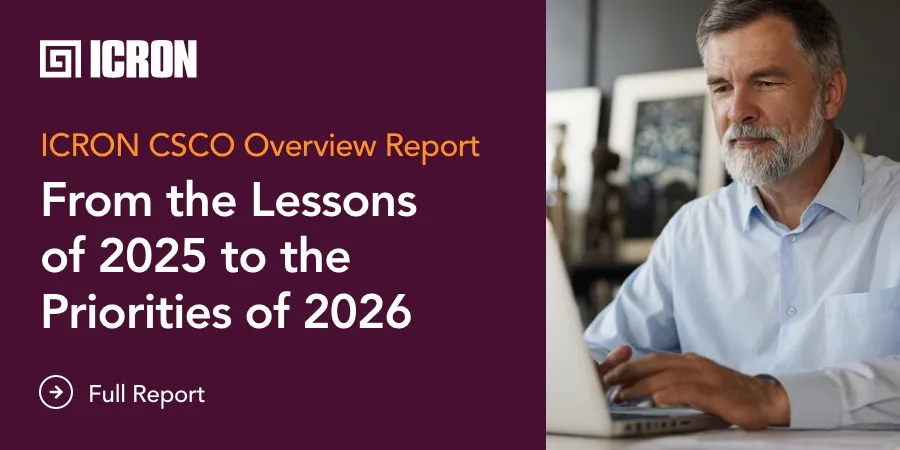
In the second part of this interview series (click here to read the first part), we speak with two leaders in the supply chain planning and optimization software industry: Dr A. Tamer Ünal – President and Founder of ICRON, a leading provider of Supply Chain Optimization and Optimized Decision Making software solutions – and Dr Jan van Doremalen– Partner and Senior Principal Consultant at CQM (Consultants in Quantitative Methods), a Netherlands-based consultancy that specializes in helping companies transform by optimizing their planning and operations and improving their product and process innovation. ICRON and CQM, founded in 1992 and 1979 respectively, are both well-established firms, and each of them boasts a growing client base that spans the globe and stretches across industries.
Over the past decade, ICRON and CQM have collaborated on numerous projects – most notably on the implementation of a sales and operations planning (S&OP) solution at high-tech equipment manufacturing giant ASML – and the two companies have cultivated a remarkable and fruitful synergy.
In the second part of this interview series, A. Tamer Ünal and Jan van Doremalen share their insights on why optimized decision making is such a crucial capability for today’s supply chain companies as well as their ideas on how supply chain planning and optimization technologies will evolve in the coming years.
Why is optimized decision making – on the strategic, tactical, and operational levels – such a critical capability for supply chain companies today?
A. Tamer Ünal (ATU): We are seeing a shift now from planning-centric to decision-centric systems.
I have been talking to executives at supply chain companies for many decades. When I first started, “planning and scheduling” wasn’t a topic, the term “supply chain” did not even exist, and there were no planning managers. C-level executives often didn’t know there was a function called “planning” in the company, so we had to explain what the planning department does to them and how it can help them. Previously, it was always a challenge to talk to C-level executives, and to explain to them the value of planning, scheduling, optimization, heuristics, mathematics, etc.
But now, with this decision making perspective, this is the first time I find myself in sync with C-level executives. When you tell C-levels about decision making, how it is important and impacts KPIs, how it covers all the functions in a company, impacts the overall operational performance, and creates business value, this resonates with them.
When we talk only about scheduling, for example, and we say we are going to make your machines run more efficiently, what is the value for the C-level executive?
But, with this decision making perspective, the overall performance of the company is the core driver in the story. There is a performance that is expected from each company that it reflected in the KPIs given to the CEOs and other C-levels, and those KPIs are designed so that the performance of the company satisfies the shareholders, and those KPIs are impacted by or determined by the decisions made and actions taken by the company’s people (planners, distributors, salespeople, etc.). Decision making is not an obscure function that is done by some people in the company, but it is actually a direct determinant of the performance of the company – and I think this perspective is really clicking with C-level executives today.

The question is not whether that makes sense or not, but how can we convey this information to companies. How can we make sure that they understand the value of this decision-centric approach and the connection between their decisions and business goals? It is very easy to say all these things in a high-level manner, but still push the old technologies. We should be able to show the difference between using a planning paradigm and a decision making paradigm.
Solving a mathematical model is not a decision process. It just produces a calculation or a report. How can your planners and key stakeholders interpret that calculation or report and turn it into a decision? This is the real deal.
You can have two planners who make two different decisions based on the same Gantt chart or report. That is an issue. It’s where the planning systems are misleading people – telling them that they are solving their supply chain problems. They may be solving mathematical planning problems, but they are not enabling optimized decisions.
In this decision making paradigm – which places the emphasis on the decision making rather than solving the planning problem – you still need all the data and the calculations, but the calculations are not the end of the story. You have the calculations and can show these as a Gantt chart or report or in another format, but this result in not a decision. The decision only becomes a reality at the time of action: when you need to place an order, quote a due date, confirm a shipment, etc. – that is the point of decision. How does the system immediately help you or provide you with the optimized decision at that decision point? That’s the basic difference between a decision-centric and planning-centric perspective.
Jan van Doremalen (JVD): Decision making is a crucial capability. Often companies are focused on improving their processes, but ultimately the processes are just a means to an end – which is improving the decisions. You must have the capability to make the right decisions.
And the decisions need to be oriented towards certain KPIs or performance measures, which are different for different companies.
One of the things that optimized decision making should make possible is the consistency of decision making across strategic, tactical, and operational levels. To do this, there must be an integrated decision making framework in place.

Optimized decision making is a combination of the people, the systems, the data, and the processes – which collectively form the entire decision making framework of any organization. Only by utilizing all these elements together can you achieve optimized decision making.
Indeed, to achieve optimized decision making, companies must first assess their planning and operational situation to see where they are, what their decision quality is, and what the quality of their people, processes, and systems are. It’s good to think big, but in each project we have to start small, work with what’s available at the time, and grow fast.
You can also look at this from a strategic, tactical, and operational perspective. Each company tries to set certain goals and objectives on each of these levels. Once you have these goals and objectives in place, along with the right people, processes, and systems, you can make optimized decisions. Optimized decisions enable a company to accomplish its objectives and goals.
What are the red flags or signs that a planning and scheduling system is not effectively enabling optimized decision making?
ATU: Very simple. Ask the planner, when a problem happens, what does he do? Does he call someone else to ask for something? Or does he have a hidden Excel sheet somewhere, on which he keeps track of things outside the system so that he can manage certain flexibilities, which he cannot accomplish in the system? Or does he look to the system to provide the answer?
If there’s an Excel that’s running parallel to the system and if, in times of crisis, the planner doesn’t look at the system, but they ask someone else, look at an Excel sheet, do something else or do a calculation, then that system is garbage. If the decision maker doesn’t trust the system and needs to double check it or find another source of information so that he can make more informed decisions, then the system is useless. Most probably the company keeps the system because of reporting and graphs or something else, but not for decision making.
JVD: What we see very often is that the decisions in a company are not consistent and are not aligned with the company’s high-level objectives and goals.
Whenever we start a project at a company, we must ensure that we involve and empower the planners that are there. There are two common pitfalls that we often encounter. Firstly, the planners often still want to work in the ways they are used to. Secondly, they are constantly changing the proposals that come out of the decision support system. That’s tricky. When you push the optimization button, you get a completely different plan, and it’s sometimes hard to get the planner to trust that new plan.
That’s something that we as ICRON and CQM need to think about how we are going to deal with. We all believe in optimized decision making solutions, but these have an impact on people and require a shift in mindset. We need to take this people aspect into account.
If we frame the story right, I think people will really understand what this is all about. They will realize that in order to make optimized decisions and achieve your business objectives and goals, you need the right systems, processes, data, and people in place. I think this is a really strong story, and that people will ultimately buy into it.
How do you think supply chain planning and optimization technologies will develop in the coming years?
ATU: I think the structure of applications needs to change. Previously it was more like monolithic applications solving large-scale optimization models or planning and scheduling problems. But as the focus shifts towards optimizing the decision processes rather than mathematical models, I think applications should become smaller, faster, and distributed rather than centralized, consistent, and monolithic.
Enterprise resource planning (ERP) systems were actually a transformation in the 1960s, 1970s, and 1980s, in the sense that they were getting rid of silos. Everything became connected and consistent, so whatever various departments were doing had the same structure and connectivity to a common data structure. This connectedness is important in managing a corporate data infrastructure, but when you think about an ever-changing environment, when you think about flexibility and the decision processes, consistency is not the first goal. You don’t even need consistency. What you need is agility.
I think that agility – rather than enterprise-wide consistency – will be a major trend in the future.
In fact, in certain decision processes, you do not need that consistency. And trying to obtain that consistency can cause you to lose time and lose your edge.
With the decision-centric perspective, the consistency, optimality, and accuracy of solving mathematical models is not a concern. The main concern is the action that is connected to a decision. Is the solution giving you good advice at the end? Who cares if it is finding the optimal solution always – as long as it is giving me the optimal final advice. The key question is not “are we optimally solving the problem”, but “is this the optimal way to solve this problem?”
Is the solution optimal is the last thing you should ask. If an infeasible, inaccurate, partial or even stupid solution leads you to the same action, why not? If it is faster to do. That’s why we are talking about the optimality of decisions, not the optimality of the solution to the problem. In the end, what you should care about, today – in terms of purchasing, product, shipment – is that you made the optimal decisions.
Another trend that I think we will see in the future is greater communication and collaboration across the supply chain. Today most decisions are made within organizational boundaries, but as communication and collaboration within organizations and supply chains becomes stronger, inter-company communication and centralization of decisions across the supply chain becomes more and more possible.
When you think about it, there are already certain attempts at doing that, but those things only work for supply chains that have tight integration like automotive. It’s not about sharing data with your suppliers or customers, but it’s about how you can collectively embed collaboration in your processes and collaborate in decision making across your supply chain.
This is not a technological issue – technology can already do this – the problem is how do you bring businesses (even competitors) into it, how to you share value (balance KPIs and distribute costs and benefits) and build trust? We are talking about an organizational business transformation, rather than a technological transformation.
JVD: When I started my career, most of the optimization systems used linear programming and a bit of integer programming – but with these we couldn’t solve complex planning and scheduling problems. One of the things that has evolved over time is this type of technology, which can now handle way larger problems, way more effectively. A lot of development is still happening around those basic technologies.
Also, over the past 25 years, heuristics, genetic algorithms, simulated annealing, AI, and machine learning have really developed because the technology has developed – so more is possible. When I began my career, all of these and many other techniques were there as concepts, but we couldn’t use them because the technology was so primitive and they were only later developed as technological solutions.
It’s all still evolving – the technology is developing and there are more and more possibilities.
In the coming years, optimization and simulation technologies will become even faster and more responsive and will use more and more data. We will see completely data-driven supply chains, and the consequence of this is that many decisions will be automated. People need to start thinking about this and believing in it. This will create many challenges and opportunities.
As the experts, we have to think about the consequences of these automated, data-driven systems. For example, the feedback loop. You always have the responsibility to make sure that you have the monitoring and control in place to see whether you are moving towards the objectives of your company. That is one of the challenges we have together as CQM and ICRON. When we build systems together that automate decisions without human interference or intervention, we need to think about the monitoring and control mechanism. This is to ensure that the decisions that are made are the right decisions.













